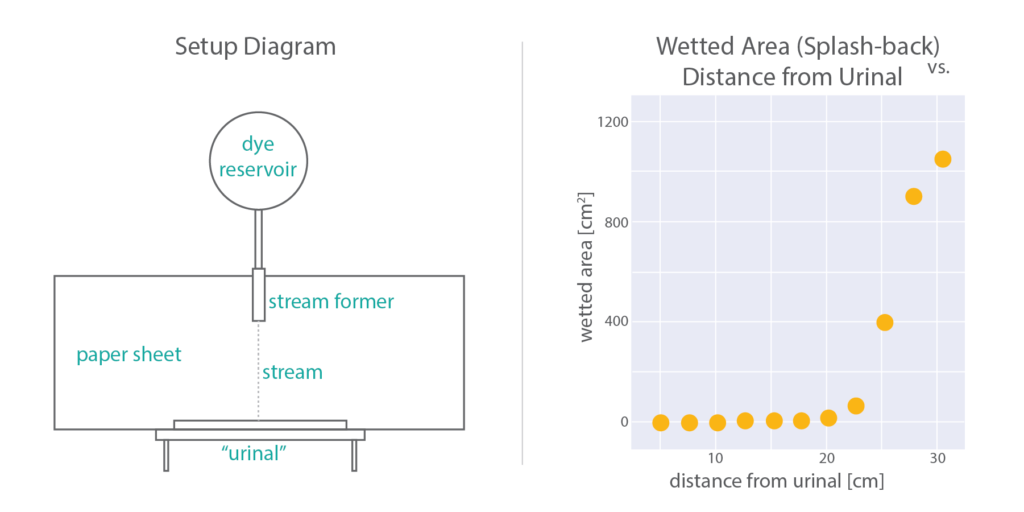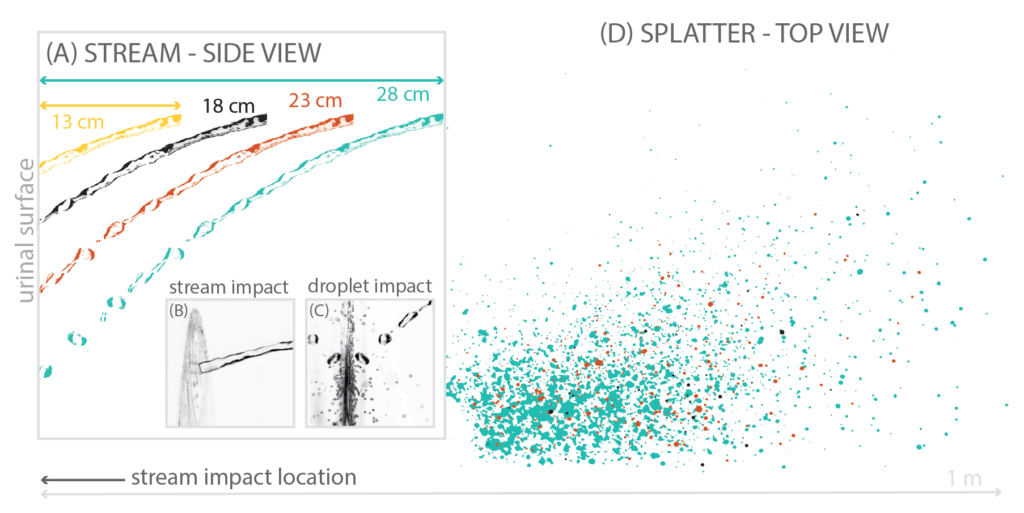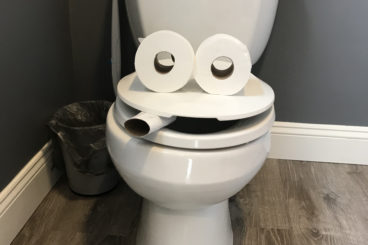Jackson Pollock on Your Bathroom Wall

Most men have likely found themselves using a restroom while wearing sandals; the mundaneness of this act is frequently shattered by a horrifying realization that you can feel tiny droplets hitting your feet. As if peeing on your own feet isn’t unfortunate enough, if you are standing at a urinal without dividers, then that light misting is most likely coming from your neighbor (wide-eyed emoji!). Why are men in the 21st century still making deposits into a receptor that spews piss right back at them? Well, it’s mostly because urinals weren’t designed to prevent splashing, but also because men are too lazy to choose the most obvious solution and sit down.
When software engineers get bored with their work, the world receives an awesome dinosaur game to play when they can’t connect to the internet. When experts in fluid dynamics get bored with their work, the results are only slightly less enjoyable; the outcome is an experimental investigation on the causes of urinal splash back. Our experimental setup consisted of a hardware store bucket connected to plastic tubing and tipped with a 3D printed Water Angle Navigation Guide to form a simulated male urine stream. The bucket was filled with dyed water. The resulting stream impacted a pane of glass (for simplified geometry) skirted with a rain gutter. At the base of this makeshift urinal we spread a large sheet of white butcher paper which collected any dyed water rebounding off of the glass. This setup is diagramed in Figure 1 (left).

for each experiment.
Dyed water was streamed for 30 seconds for each distance between source tip and glass sheet, with the paper replaced after each session. The papers were photographed and wetted area was measured using image processing software. The results from these experiments are summarized in Figure 1 (right). Splash back increases as the stream source moves farther from the vertical surface of the urinal. The amount of splash back is extremely low below 20 cm, then increases dramatically for larger distances, begging the question, “why does splashing increase so much at this distance?” Taking a closer look at the stream of water lends insight into this question.
The left side of Figure 2 shows colorized photos of our experimental ‘urine’ streams imaged from the side. Each color corresponds to a different distance from the urinal. Notice that streams farther than 20 cm begin to break into droplets before impacting the urinal wall on the left. Shorter streams are still continuous by the time they reach the wall. A continuous stream appears to make less splash, while breakup increases splash back. Stream breakup is caused by a phenomenon known as the Plateau-Rayleigh Instability 1. You may have seen this effect in your bathroom sink with the water on low enough that it forms a drizzle. It is this Plateau-Rayleigh Instability that is responsible for the increase in splashing above 20 cm.
When a stream impacts a rigid surface, the initial impact may create a splash, but the following flow of water is relatively smooth, causing little to no splashing (Figure 2 (B)). Comparatively, a single droplet impact creates a significant splashing event, ejecting several smaller droplets (Figure 2 (C)). When you consider that a urine steam, broken into droplets, can produce over 100 droplet impacts per second, you can imagine how it all might add up. Figure 2 (D) shows an overlay of splatter from several defiled sheets of paper. With the tip 28 cm (11 in) back from the urinal surface, splatter is significant (teal). At a closer distance of 13 cm (5 in) not a single droplet is found on the paper (yellow).

splashing is generated (teal).
A stream of liquid breaks into droplets due the Plateau-Rayleigh Instability. If the stream impacts a surface before this breakup occurs, then very little splash is generated. However, if the stream breaks into a train of droplets, then each impact causes a splashing event spewing tiny piss droplets onto your shoes, pants and even hands. You can envision that each successive urinal user, not wanting to step in the DNA from his predecessor, stands even farther from the porcelain and in turn makes the problem even worse. If you want to keep your sandaled feet undefiled during a bathroom break, our science-backed advice is that you need to step up – or if you are especially confident in your masculinity, just take a seat.

